When I crossed the finish line of the Coldwater Rumble 100-miler a week ago after 26 hours and 25 minutes, I felt emotionally flat-lined.
I’ve cried at finish lines before, overcome by the feeling of triumph over adversity and the sheer drama of the human effort. And I’ve done a cartwheel over the finish line, so full of giddiness and joy that I wanted to show off with a final “ta-dah!” gesture.
This time, however, I could barely muster a polite smile and “thank you” to the handful of volunteers standing around. To my stalwart pacer who’d accompanied me 40 miles through the night, I just kept saying, “I’m so glad that’s done. I’m so glad I finished. I’m so glad it’s over.”
Which begs the question, why do something if the best part about it is ending it? It reminds me of the times I skied in too-small boots with a numb big toe, pretending to enjoy the experience but inwardly suffering and eager to finish, then feeling so relieved after all those hours to get those boots off. Except this 100-miler felt much more uncomfortable than too-small ski boots.
It’s hard to articulate what was so unpleasant and discouraging about it, because objectively and in hindsight, it seems like I encountered pretty normal problems for a 100-miler: achy feet and a few blisters; fatigued muscles that stiffened and became less mobile after each of the 20-mile loops we had to run five times; low energy and sleepiness from insufficient calories caused by an inability to eat much or stomach the caffeinated gels I planned to consume during the second half; a stupid but not catastrophic gear malfunction; raspy lungs. That’s not too big of a deal. It’s what I signed up for. But right after I finished, I felt so done, as in done with 100-mile ultras.
A text I sent my friend shortly after the finish captures my headspace then:
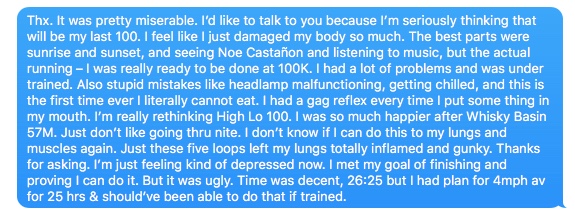
And to my sweet son Kyle who texted to ask how I was, I unloaded:

I started this race report with the ending, and the belly-aching negativity, because it’s too easy and tempting to look back misty-eyed and sanguine, reaffirming that the experience was worth it, because of course we want to believe it was worth it after putting in so much time and effort. But it’s important to remember the feeling of “ugh” and the ambivalence of wondering, “Why did I do this? Will I ever again?”
Let me try to answer the “why did I do this?”
I signed up in early November shortly after completing the Whiskey Basin 57-mile, another stellar event like Coldwater Rumble put on by Aravaipa Running. I finished that November race with a big smile, fist-pumping, and was on a high for many days. The run felt empowering, and the novelty of racing again during the pandemic felt like a special treat. I wanted more, please. So I looked at Aravaipa’s calendar and latched onto the idea of the Coldwater Rumble 100 south of Phoenix, in Estrella Mountain Regional Park, in early January.
It’d be a new year’s resolution run. It’d be a motivator to train through winter. It’d be my 100th ultra or marathon run since my first marathon in 1995, and wouldn’t it be cool to have the 100th be a 100? Most of all, it’d be the confidence-boost I need to do the mountainous 100-miler this summer, the High Lonesome 100.
I was haunted by the fact that two years have passed since I’d finished a 100-miler (though in that time, I’d finished and won the 170-mile Grand to Grand stage race in 2019, and did a 180-mile week-long Double Everest challenge last May. But that’s apples-to-bananas.) I got it in my head that I’m rusty and needed to prove I can still nail a 100-miler, now that I’m over 50.
About a week before the Coldwater Rumble, when I was finally starting to drift to sleep in spite of anxiety about the Capitol violence, my eyes flew open and I said out loud, “Oh, shit!” It suddenly hit me, for no particular reason, that I had been doing the math wrong in my head and actually three years had passed since my last 100-miler (the 24-hour New Year’s event when I went 115 miles, on new year’s eve/day 2018). I DNF’ed the 2018 Ouray 100, severely injured my back with fractured vertebrae right before the 2019 Bighorn 100, and then my goal 100 for 2020 was cancelled. So it’s been three years. I really was rusty.
“Preparation is the key to success,” my first coach, Alphonzo Jackson, always said. I prepared logistically. I made a detailed plan to achieve a best-case scenario of a 25-hour finish (figuring 24 hours was too ambitious, given the technicality of the course and my inability to train specifically in a desert environment for it). I lined up a terrific pacer and crew team—my friend Soon-Chul Choi and his girlfriend, Naomi Lee—who didn’t mind traveling to Phoenix because he had to be there for work anyway. They made a smart, generous, cheerful and dependable pacer-crew duo. So I had that going for me.

Soon-Chul and Naomi at the finish line Sunday morning.
But, I failed to put in the work of adequate training. I ran two ultras in November—the 57-mile Whiskey Basin followed by the 50K Dead Horse in Moab two weeks later—but I did not sustain high-volume training for the six weeks between Thanksgiving and New Year’s. I confronted the reality that training in winter, in snow and sub-freezing temps, while wearing a thick jacket and traction devices on my shoes, is rather slow and difficult. And I was limited to plowed forest roads, the trails being inaccessible due to snow.
Note to self: Do not sign up for a January 100 again. Take time off from structured training in December.
I did three lackluster 20-mile training runs in December. Weekly mileage hovered in the 40s to 50s (normally, for 100-mile training, I get up to 70+ miles per week for several weeks). I planned an extra-long run in late December of 37 miles or approximately 8 hours, and I cut it short at 27 miles and a little over 5 hours, totally discouraged by fatigue and lower-back pain.
So I lined up to start the Coldwater Rumble 100 at 6 a.m. on Saturday, January 16, with trepidation balanced by determination. I realized that to traverse the 100 miles, I had to make the finish non-negotiable. I eliminated quitting as an option. I only needed to remind myself of the disappointment from that 2018 Ouray 100 DNF to harden my resolve. So I actually felt pretty confident I’d finish no matter what. I just feared the experience.
The route features a 20-mile loop through desert with only about 1400 feet of elevation gain each loop. That sounds easy. But it’s a deceptively difficult course due to the terrain (reportedly much harder than Aravaipa’s Javelina Jundred, which also is a 5 x 20M loop course in the desert). Many parts of it are rocky. One stretch features some deep sand. Numerous gullies, forming big deep ditches, intersect the trail, so you have to slide down an embankment and scramble back up the other side. The route is fully exposed, so sun beats down and reflects off the light-colored sand, making it feel hotter than the high-70s temperature. At night, the temperature drastically drops below 40. And it’s January, with a new moon hanging as a thin sliver in the starry sky, so it’s really dark for more hours than a summertime 100! The sun doesn’t rise until about 7:30 a.m. and sets around 5:45 p.m.
Looking back, as much as I recall the discomfort and discouragement, I also remember the good times. When I started in the pre-dawn darkness, in a small wave of 10 other runners (the small-wave starts were part of covid precautions), I felt smooth and self-assured. For the first 90 minutes until sunrise, I had to focus intently on the trail to avoid tripping and to follow course markings on the unfamiliar route. Ahead of me, around mile 5, a woman went down and moaned while clutching her knee and dabbing blood. Her mishap inspired a corny but effective mantra that I inwardly repeated through sunrise, “Concentrate, doing great.”
The three separate twilight hours of the first sunrise, then the sunset, and then the second sunrise the next morning were probably my favorite three hours on the course. It’s difficult to describe the beauty of an orange band of light on the horizon creating silhouettes of the mountain ridges and the tall saguaro cacti, and the wash of a pink hue progressively lighting up the darkened landscape (or conversely, at sunset, dimming the light). I didn’t bother taking a photo because I knew it wouldn’t do the scene justice. But these pink-and-orange twilight hours filled me with awe, which in turn lifted my spirits and renewed my energy.
I finished the first loop as planned, in 4 hours averaging a 12 minute-per-mile pace. I deliberately went out faster than I knew I could maintain because I needed to bank time before slowing in the daytime heat. I don’t regret that strategy; the 5mph pace the first loop felt fine. I headed out on loop 2 thinking of another favorite mantra, the play on words obvious, “so far, so good.”
Loop 2, I started to bake. First I felt the heat in my feet, which warmed up more than usual because I wore black fabric gaiters on my shoes to keep out sand (reflective white fabric would’ve been smarter). Heat plus sweat plus friction equals blisters, and sure enough, I felt a couple sprout on my toes. Then my fingers started to swell like sausages, which was a bad sign of stress only a quarter to a third of the way through this event. Swollen hands can result from over-hydrating without adequate salt; the body pulls fluid out of the overly diluted blood stream, to restore the proper salt balance, and stores it in intercellular space, making fat fingers. But I thought I was getting adequate electrolytes from sports drink and gels, so who knows why I became so puffy. It’s likely that every blood vessel in my body dilated as much as possible to keep blood flowing to my muscles and to my skin, in an attempt to cool off.
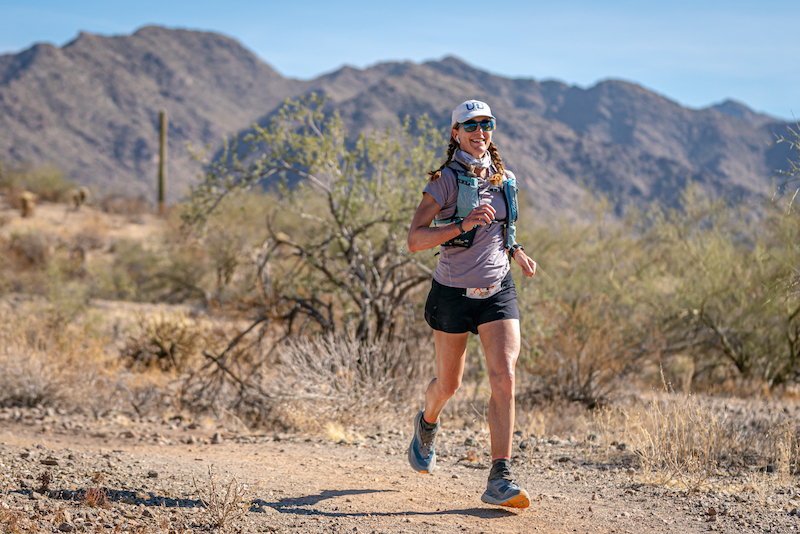
Feeling extra hot around mile 37, near the end of Loop 2. Photo by Jubilee Paige. (Don’t be fooled by my smile. I smiled briefly only because I was happy to see Jubilee and her dog. Jubilee administered first aid to my cut-up forearms at an ultra three years ago, so I’m always happy and grateful to see her.)
By 2 p.m., as I approached the end of Loop 2, my body felt like a car engine straining up the Grapevine near LA in triple-digit heat. When Soon-Chul met me at the entrance to the main start/finish aid station and asked what I needed, I said, “Shade, and the towel soaked in ice water.” I also told him not to tell me where I was in terms of placing in relation to others. I truly did not want to know. I entered this event telling myself, “I’m not racing, I’m finishing.” I knew if I got caught up in competition, I risked blowing up. Thankfully, neither Soon-Chul nor anyone else ever mentioned where I was in the ranking, so I had no idea I was one of the top women, and I kept my non-competitive, stick-to-my-own-plan plan.
I hunched over in some shade of the aid station, and Soon-Chul and Naomi draped my head and shoulders with a towel dripping with ice-cold water. It was just what I needed. I managed to eat some potato chips, chug a whole can of La Croix sparkling water followed by a whole can of Izzy berry soda, and I lathered myself with more sunscreen. Loop 2 took me about 4.5 hours, which is what I had planned, so I wasn’t falling behind my goal, yet. I headed out on Loop 3 feeling much better, looking forward to the twilight hour before sunset.
As on Loop 2, I enjoyed my playlist for Loop 3. When I felt discouraged and when my feet hurt every time I kicked a rock, I focused on the song lyrics. If music didn’t make me feel better, then I focused on the cacti. I’m fascinated by the shapes of tall saguaro cacti, which stand like tree people. And the shorter cacti come in a fascinating variety. Some were hollowed-out webbed structures, as if the cactus plant had died and left a cylindrical skeleton woven like a net. If I could focus on the details around me, practicing mindfulness, then I could keep making forward progress. “All that matters is this mile” became another mantra.

Cacti like this grow all around Estrella Mountain Regional Park. I took this photo the day before the race, when I was checking out the route’s first couple of miles.
I felt as good as I had all day during the twilight hour, because my body temperature cooled off and I could run more comfortably while soaking in the sunset glow. Predictably, after the light disappeared and I switched on my headlamp, I slowed considerably. Coming into the midway aid station with about 5 miles left of Loop 3 (around Mile 55), I tripped and fell hard on my hands. I was OK, but that fall rattled my confidence and made me even more tentative about running in the dark.
I reached the main start/finish aid station, at the end of Loop 3, only about 10 minutes behind my planned schedule, around 7:40 p.m. I budgeted extra time at this stop, to eat the equivalent of dinner and put on extra layers of clothing for nighttime. I was in a better mood, excited to have Soon-Chul’s company for the final two loops.
In the light of the aid station, I looked up and registered a face, totally unexpected and somewhat but not entirely familiar because a mask covered his signature mustache. When I heard his voice and realized who it was, I felt my face nearly break with a smile. It was Noé Castañón, an old friend—everybody’s friend—from the Bay Area. He seems to turn up everywhere. He and I last ran together at that new year’s 24-hour event in San Francisco, when he showed up at sunrise to run some laps with me, repeatedly yelling, “¡Fuerte, corre!”
My Spanish came surprisingly naturally given my tired mind. “Noé, estás aquí? De verdad? Me alegro de verte! Qué sorpresa!” (Noé speaks perfect English, but he has always entertained my attempts to practice Spanish with him when we see each other.) Seeing him made me feel reconnected to the ultra community in a way I haven’t for quite some time.
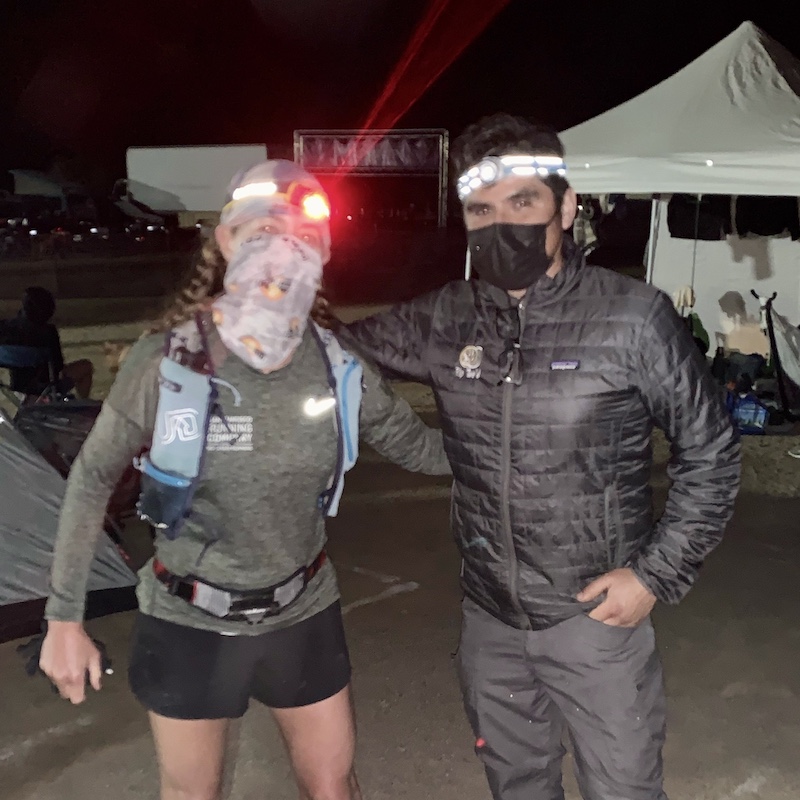
Reconnecting with Noé Castañón at the Mile 60 stop.
When none of the food options seemed appealing, Soon-Chul offered me a piece of pizza, which tasted surprisingly good. It would be my last significant bit of food for the next 12 hours. Soon-Chul and I headed into the night. As we hiked the first rocky hill, I realized I felt stiff and tired after the high of my reunion with Noé, and I was grateful for Soon-Chul’s company.
I honestly don’t remember much about Loop 4, except it was nice chatting with Soon-Chul and playing tour guide to every segment of the route, since he hadn’t run it before but I was by now thoroughly familiar with it. I also stopped repeatedly to pee. I think he was shocked by how much and how frequently I had to urinate. I myself was kind of shocked. I knew the scientific explanation: cold diuresis. My blood vessels were constricting in the chilly nighttime air, and blood was flowing to my core to keep me warm. This stimulated my kidneys. I hadn’t peed much during the day due to stress. But I had stored gallons of fluid. I couldn’t believe how much I had to go on Loop 4. While it felt relieving, it contributed to my stiffness and let a chill creep into my extremities while having to start and stop so frequently, unable to get in a rhythm of sustained running.
Midway through Loop 4, a food aversion also kicked in. GU gels, which I normally always can suck down, seemed nasty so I stopped trying them as an option. The nicely prepared quesadillas and potato soup at the aid station also got stuck in my throat. I literally did not want anything in my mouth. Ginger ale and diluted Gatorade became the only things I could swallow in small sips at aid stations.
We made it to the end of Loop 4, Mile 80, around 1:45 a.m. which was only about 15 minutes off my plan, so I was still doing pretty well. But I felt depleted and grumpy, so decided to give myself extra time to rejuvenate and try to eat. The blisters that had been talking to me were now shouting, and I could feel grit in my socks. Soon-Chul convinced me to take time to fix my feet so the final lap would feel better. He and Naomi bundled me in a blanket and a down puffy, and for the first time since the start, I let myself sit in the chair (“beware the chair”). We stripped off my gaiters, shoes and socks, and Naomi asserted herself with cleaning my toes and popping my blisters. I was impressed. My feet were disgusting, but she didn’t wince. Later I discovered she has a nursing degree, so that helps explain her skilled caregiving.
My feet felt better in clean socks and fresh shoes, but the rest of me felt clumsy and cold. In spite of all the layers, I caught a bone-deep chill. I tried to eat what they offered, and managed a few bites of avocado and a single lump of potato from the potato soup, but food was not my friend on this night. I realized I had to get moving or I’d be stuck in that chair. When I stood to move, I nearly fell over. My jaw started spasming with big chatters, and my shoulders got all herky-jerky. When I tried to walk, I stumbled along the quarter-mile paved stretch to the trail—the stretch I had vowed at the start of the event to always run, and now I could barely walk. I knew I would feel better once I hit the uphill and my body warmed up again, and that proved true. I could walk and talk more normally after a mile. But I was still cold and stumbling, suffering a case of “the stupids,” foggy in the head.
The main thing I recall from Loop 5 is saying to every intersection on the route and every loose-rock gully, “good-bye and good riddance.” My only source of pleasure derived from knowing I would never have to pass by that spot again. Every step, every completed section, got me closer to finishing. That fact sustained me when everything hurt. My lungs hurt when I breathed deeply. My knees hurt when I went down a hill. With virtually every footfall, my feet and quads registered sharp twinges as if being jabbed with a skewer. Even my eyeballs hurt when I blinked, because my eyes were too dry.
On this final loop, my annoying headlamp that gave me a headache dimmed to the point of uselessness, even though I had put fresh batteries in it. Thankfully, I had a hand-held light, but it dimmed too. Soon-Chul’s light was strong enough for both of us, so I ran closer by his side. At around Mile 90, he paused to swap out his headlamp’s battery, using the dying light of my flashlight.
At that moment, as we huddled in the darkness cursing our light source, a woman ran by all lighted up with extra-bright Kogalla lights, the lighting system that works by putting a strip of powerful lights on a hydration pack’s strap. I had tried to buy Kogalla lights before the race, but they were sold out and back-ordered, presumably due to supply and distribution problems caused by the pandemic. I felt a wave of jealousy toward this woman. But then she called out, “Hey, Sarah!” and I realized it was Jess Mullen, whom I like and admire. I was surprised, because I thought she had been ahead of me all day. I was glad she was having a good finish—if not me, then her. (She’d end up finishing second woman in just under 26 hours.)
I knew I had fallen way behind my goal of a 25-hour finish, even 26 hours, based on our snail’s pace and my too-long stops at aid stations trying unsuccessfully to choke down food. But I knew I would finish. I just had to get the work done. Every mile dragged. I cheered myself up with the prospect of dawn, and indeed daybreak was lovely. The sun came up. I warmed up enough to take off my down puffy and tie it around my waist. I kept shuffling forward, repeatedly breaking into a run for a 30-second burst and then resigning myself to hiking. I just wanted it to be over. Please, make it stop.
Naomi thoughtfully positioned herself at the base of the final hill to await our arrival. Standing in the freezing cold, waiting for us for who knows how long, she remained so cheerful and seemed so excited to see us. I wanted to mirror her enthusiasm, but I just felt badly that I had dragged her and Soon-Chul out for a night that at the time seemed almost pointless. “Thank you so much for being here,” I told her, “I’m so sorry you had to wait so long.”
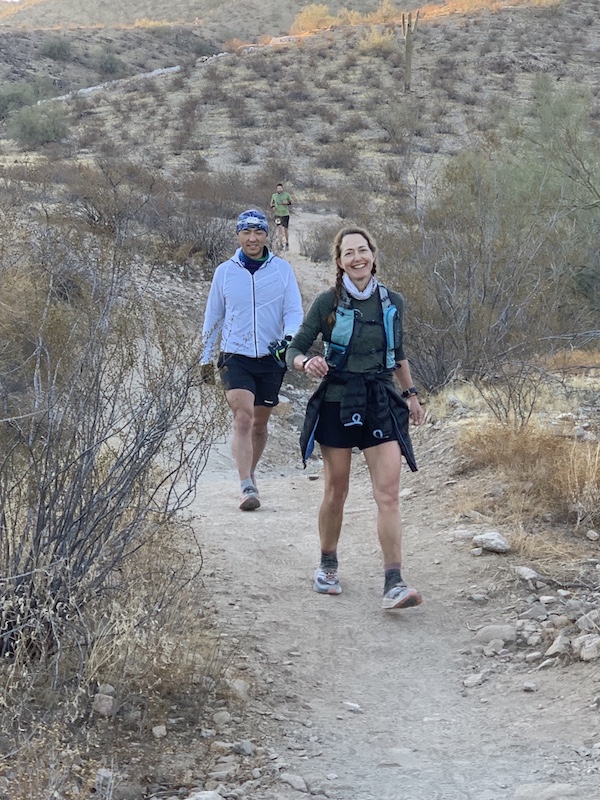
Naomi’s photo of Soon-Chul and me coming down the final hill toward the finish line.
The three of us jogged the short paved stretch to the finish together, and I crossed the line at 26:24:56. At that moment, I did not care. It did not matter. The only thing that mattered to me was going to the bathroom, taking off my gross shorts whose elastic band on the liner had started to chafe my crotch, throwing the shorts in the trash, putting on fresh leggings, and washing my hands with soap. I did all those things, and then I was able to hang out at the finish line with Soon-Chul and Naomi and thank them and repeatedly mention how glad I was to be done.
I was informed that I had placed third female, to which I ungratefully replied within earshot of the race director, “Well, that must mean this event has a pretty small and uncompetitive field.” He looked hurt, and I wished I could take back that remark. But it’s true, I should not have earned a podium spot. I got third only because the female finishers numbered a measly seven. I was midpack overall, 27th out of 48 finishers. The event had a high DNF rate—out of 86 starters, 38 dropped. (Results.)
But I was grateful for the 3rd place prize, and the buckle, because Aravaipa Artworx does such a cool job designing and laser-cutting its awards.
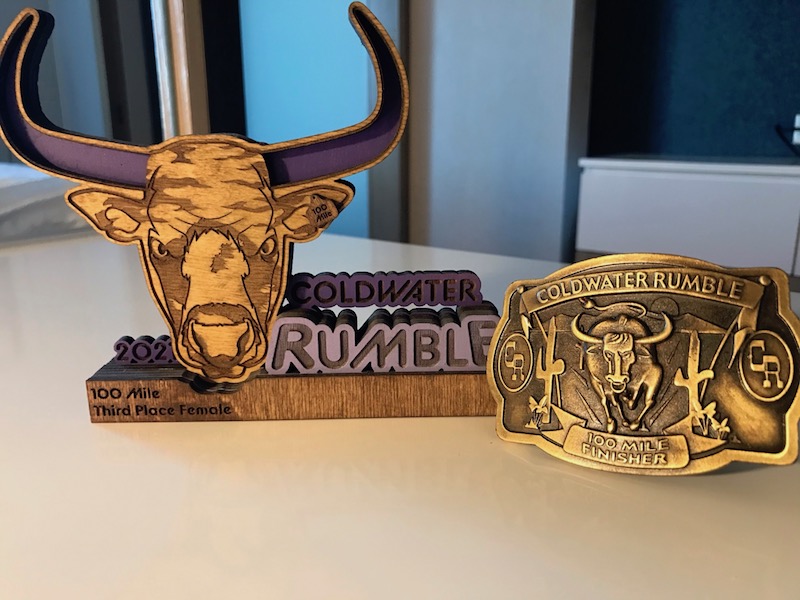
I made it back to my hotel room and felt defeated in spite of finishing, because I felt so trashed. The final 40 miles had been a suffer-fest in spite of my pacer’s best efforts to support me. My whole body felt damaged. My skin was sunburned, my breathing triggered coughing fits in spite of using an asthma inhaler, and every muscle ached.
I couldn’t stop thinking about the summertime High Lonesome 100 and second-guessing my desire to run it. Coldwater Rumble is a much easier 100 than High Lonesome. High Lonesome will take me around 36 hours instead of 26. Given how weak I felt in the second half of this 100, what am I getting myself into with High Lonesome?
Another ultrarunning friend wisely and kindly messaged:
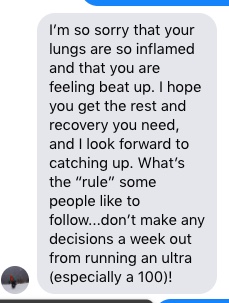
So I’ll return to the question I posed near the top, “Will I ever again?”
Predictably, with each passing day this past week, I began to view my mid-race difficulties and discomfort from a new perspective. I felt better about my performance, realizing I did pretty well given the training I put into it.
I found myself browsing the entrants’ list for High Lonesome 100 and feeling a strong pull to go on that 100-mile journey with the names I recognize on the list. It will be one giant loop, not repeat loops. It’ll be through the Collegiate Peaks that I want to see up close.
The more I think about last weekend’s 100, the more I want to train properly this spring and summer to do it right next time. Yes, there will be a next time.

Ah, now I know why I was peeing every couple miles on my long run yesterday in 20 degree weather!
These types of adventures, that break us down, are important to have in life. When we have these deeps lows, we can really feel the highs. With a drop out rate of almost 50% you already have a big win with 3rd place. Most did not even make it to the finish line! So, look at that award with pride knowing that you finished and that you gained a lot from the event you will be able to appreciate at a later date.
Sarah,
Your race sounds like mine when I did Coldwater in 2020. There were also a lot of DNFs (50%). It’s deceptively tough with chunky rocks and cold nighttime temperatures. I slept on rocks and at aid stations but was delighted to finish and be done with it. Looking back now, it’s a great memory considering how terrible the rest of 2020 was. Great effort and race report!
Smith
You should be proud to have toed the line and congrats on your finish. A January 100 is no joke for anyone, never mind coming from CO. I think you probably just never got the break you needed over the holidays with the prospect of a 100 hanging over your head, kids home, new puppy, dark cold days of winter, the world falling apart… it’s no wonder. I have a strong suspicion you will be back and ready for High Lonesome, but if not, so what? Perhaps sometimes we just need to follow our gut and heart and let the shoulda/woulda go.
Oh man, you describe the lows so well! I’ve definitely been ambivalent about running 100s after the tough ones, but I keep coming back for more, too. Thanks for writing up this experience in such (grim!) detail. I think so many of us like to visualize having a perfect, glorious race, but it’s much more important to realize, and truly accept, that there will be some suffering out there. Less suffering with more training, but still some parts are gonna suck. But pushing through those times and getting it done is what it’s all about, right? And when your soul and body are raw, you can really commune with the beauty around you … if not in the moment, at least in your memories!
You might not be ready to embrace this yet, but holy sh!t, Congratulations on a hard fought finish! Winter training is no joke and you are better positioned to tackle the High Lonesome 100. I will take your don’t quit attitude AND your awesome Spotify playlist with me as I train for my August 100.
So inspiring, Sarah. You show us again and again that our disadvantage is our differentiation. And you stand out for your unique blend of vulnerability and power.
Frequently misattributed to Aristotle, but more accurately written by Will Durant “We are what we repeatedly do. Excellence then is not an act. It is a habit.” Once again, I hope more in the outside world read your work. More to the point, instead of getting pithy regarding attribution nonsense, A++ per usual.
I will spare you the platitudes and my normal demotics and say that once again your writing was relatable, on point, authentic, and more. Not even going to get into your pedigree and impressive running resume (which stands for itself, champ) but you write with integrity. A true leader with character. The most effect part of your writing is how you share and teach. The single reason I write this is to compliment this continual effort on your part and what that endows to those who stumble upon it. A consistent jackpot. Jesus I can’t help myself.
But all kidding aside, Sarah, keep writing and remember, regardless of the outcome of your time on legs, you perform and write at the highest level no matter what goes down on the trail. Everyone needs a gifted navigator to understand the elusive nature of things big and small. Even though conversations are important they are bite-sized and ephemera. You have lock on chronicling with brio the ultra/trail running experience and are our gifted laureate. Bravo!